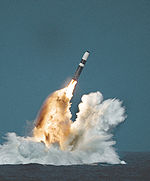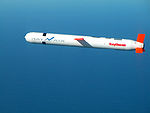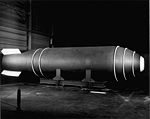- Nuclear weapons delivery
-
Contents
Nuclear weapons 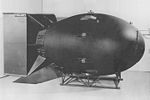
History
Warfare
Arms race
Design
Testing
Effects
Delivery
Espionage
Proliferation
Arsenals
Terrorism
Anti-nuclear oppositionNuclear-armed states United States · Russia
United Kingdom · France
China · India · Israel
Pakistan · North Korea
South Africa (former)Nuclear weapons delivery is the technology and systems used to place a nuclear weapon at the position of detonation, on or near its target. Several methods have been developed to carry out this task.
Strategic nuclear weapons are used primarily as part of a doctrine of deterrence by threatening large targets, such as cities. Weapons meant for use in limited military maneuvers, such as destroying specific military, communications, or infrastructure targets, are known as tactical nuclear weapons. In terms of explosive yields, nowadays the former have much larger yield than the latter, although it is not a rule. The bombs that destroyed Hiroshima and Nagasaki in 1945 (with TNT equivalents between 15 and 22 kilotons) were weaker than many of today's tactical weapons, yet they achieved the desired effect when used strategically.
Main delivery mechanisms
Gravity bomb
Main article: Bomb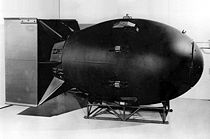 The first nuclear weapons, such as the "Little Boy" and the "Fat Man" devices, were large and cumbersome gravity bombs.
The first nuclear weapons, such as the "Little Boy" and the "Fat Man" devices, were large and cumbersome gravity bombs.
Historically the first method of delivery, and the method used in the two nuclear weapons actually used in warfare, was in a gravity bomb dropped by a bomber. In the years leading up to the development and deployment of nuclear-armed missiles, nuclear bombs represented the most practical means of nuclear weapons delivery; even today, and especially with the decommissioning of nuclear missiles, aerial bombing remains the primary means of offensive nuclear weapons delivery, and the majority of U.S. nuclear warheads are represented in bombs.
No nuclear weapon qualifies as a "wooden bomb"—US military slang for a bomb that is trouble-free, maintenance-free, and danger-free under all conditions. Gravity bombs are designed to be dropped from planes, which requires that the weapon can withstand vibrations and changes in air temperature and pressure during the course of a flight. Early weapons often had a removable core for safety, installed by the air crew during flight. They had to meet safety conditions, to prevent accidental detonation or dropping. A variety of types also had to have a fuse to initiate detonation. US nuclear weapons that met these criteria are designated by the letter "B" followed, without a hyphen, by the sequential number of the "physics package" it contains. The "B61", for example, was the primary bomb in the US arsenal for decades.
Various air-dropping techniques exist, including toss bombing, parachute-retarded delivery, and laydown modes, intended to give the dropping aircraft time to escape the ensuing blast.
The early gravity nuclear bombs could only be carried by the B-29 Superfortress. The next generation of weapons were still so big and heavy that they could only be carried by bombers such as the B-52 Stratofortress and V bombers, but by the mid-1950s smaller weapons had been developed that could be carried and deployed by fighter-bombers.
Ballistic missile
Main article: Ballistic missileMissiles using a ballistic trajectory usually deliver a warhead over the horizon, at distances of hundreds up to thousands of kilometers, as in the case of intercontinental ballistic missiles (ICBMs) and submarine-launched ballistic missiles (SLBMs). Most ballistic missiles exit the Earth's atmosphere and re-enter it in their sub-orbital spaceflight.
Placement of nuclear missiles on the low Earth orbit, a truly fearsome option, has been banned by Outer Space Treaty as early as 1967. Also, the eventual Soviet Fractional Orbital Bombardment System (FOBS) that served a similar purpose—it was just deliberately designed to deorbit before completing a full circle—was phased out in January 1983 in compliance with the SALT II treaty.
An ICBM is more than 20 times as fast as a bomber and more than 10 times as fast as a fighter plane, and also flying at a much higher altitude, and therefore more difficult to defend against. ICBMs can also be fired quickly in the event of a surprise attack.
Early ballistic missiles carried a single warhead, often of megaton-range yield. Because of the limited accuracy of the missiles, this kind of high yield was considered necessary in order to ensure a particular target's destruction. Since the 1970s modern ballistic weapons have seen the development of far more accurate targeting technologies, particularly due to improvements in inertial guidance systems. This set the stage for smaller warheads in the hundreds-of-kilotons-range yield, and consequently for ICBMs having multiple independently targetable reentry vehicles (MIRV). A single missile would now be used to launch an entire "bus", releasing up to a dozen independent warheads into a dozen different ballistic trajectories. MIRV has a number of advantages over a missile with a single warhead. With small additional costs, it allows a single missile to strike multiple targets, or to inflict maximum damage on a single target by attacking it with multiple warheads. It makes anti-ballistic missile defense even more difficult, and even less economically viable, than before.
Missile warheads in the American arsenal are indicated by the letter "W"; for example, the W61 missile warhead would have the same physics package as the B61 gravity bomb described above, but it would have different environmental requirements, and different safety requirements since it would not be crew-tended after launch and remain atop a missile for a great length of time.
Cruise missile
Main article: Cruise missileA cruise missile is a jet engine or rocket-propelled missile that flies at low altitude using an automated guidance system (usually inertial navigation, sometimes supplemented by either GPS or mid-course updates from friendly forces) to make them harder to detect or intercept. Cruise missiles can carry a nuclear warhead. They have a shorter range and smaller payloads than ballistic missiles, so their warheads are smaller and less powerful.
Unlike conventional cruise missiles, which sometimes use cluster munition payloads, and unlike bombers, nuclear armed cruise missiles have a single warhead.
The AGM-129 ACM (Advanced Cruise Missile) is the US Air Force's current nuclear-armed air-launched cruise missile. The START II treaty forbids the USA from using stealth weapons on stealth aircraft, therefore the ACM is only carried on the B-52 Stratofortress. This plane can carry 20 missiles. Thus the cruise missiles themselves can be compared with MIRV warheads. The BGM/UGM-109 Tomahawk sea-launched cruise missile is capable of carrying nuclear warheads, but does not in present configurations.
Cruise missiles may also be launched from mobile launchers on the ground, and from naval ships.
There is no letter change in the US arsenal to distinguish the warheads of cruise missiles from those for ballistic missiles.
Cruise missiles, even with their lower payload, have a number of advantages over ballistic missiles for the purposes of delivering nuclear strikes:
- Launch of a cruise missile is difficult to detect early from satellites and other long-range means, contributing to a surprise factor of attack.
- That, coupled with the ability to actively maneuver in flight, allows for penetration of strategic anti-missile systems aimed at intercepting ballistic missiles on calculated trajectory of flight.
Partially for those reasons, nuclear-armed cruise missiles are amongst the least deployed of all nuclear weapons, as their deployment is restricted by treaties such as SALT II.
Other delivery systems
 The Davy Crockett artillery shell is the smallest known nuclear weapon developed by the USA.
The Davy Crockett artillery shell is the smallest known nuclear weapon developed by the USA.
Other potential delivery methods include artillery shells, mines such as the Medium Atomic Demolition Munition and the (very odd) Blue Peacock, and nuclear depth charges, and nuclear torpedoes. An atomic mortar was also tested. Even an 'Atomic Bazooka' was designed to be used against large formations of tanks.
In the 1950s the U.S. developed small nuclear warheads for air defense use, such as the Nike Hercules. From the 1950s to the 1980s, the United States and Canada fielded a low-yield nuclear-tipped air-to-air rocket, the AIR-2 Genie. Further developments of this concept, some with much larger warheads, led to the early anti-ballistic missiles. United States' have taken nuclear air-defense weapons out of service. Russia continues to maintain the Soviet anti-ballistic missiles with nuclear warheads.[citation needed]
Small, two-man portable tactical weapons (erroneously referred to as suitcase bombs), such as the Special Atomic Demolition Munition, have been developed, although the difficulty to combine sufficient yield with portability limits their military utility.
See also
- History of nuclear weapons
- List of nuclear weapons
- Mutual assured destruction doctrine
- National missile defense of the United States
- Nuclear explosion
- Nuclear strategy
- Nuclear weapon design
- Nuclear terrorism
Notes
References
External links
Nuclear technology Science Fuel Deuterium · Fertile material · Fissile · Isotope separation · Plutonium · Thorium · Tritium · Uranium (enriched • depleted)Neutron Activation · Capture · Cross-section · Fast · Fusion · Generator · Poison · Radiation · Reflector · Temp · ThermalReactors Boiling (BWR · ABWR) · Heavy (CANDU · PHWR · SGHWR) · Natural (NFR) · Pressurized (PWR · VVER · EPR) · Supercritical (SCWR)Advanced gas-cooled (AGR) · Magnox · Pebble bed (PBMR) · RBMK · UHTREX · Very high temperature (VHTR)FLiBeNone
(Fast)Breeder (FBR) · Integral (IFR) · Liquid-metal-cooled (LMFR) · SSTAR · Traveling Wave (TWR)
Generation IV by coolant: (Gas (GFR) · Lead (LFR) · Sodium (SFR))OtherPower Medicine TherapyWeapon TopicsListsWaste ProductsActinide: (Reprocessed uranium · Reactor-grade plutonium · Minor actinide) · Activation · Fission (LLFP)DisposalDebate Nuclear power debate · Nuclear weapons debate · Anti-nuclear movement · Uranium mining debate · Nuclear power phase-outCategories:- Nuclear weapons
Wikimedia Foundation. 2010.

